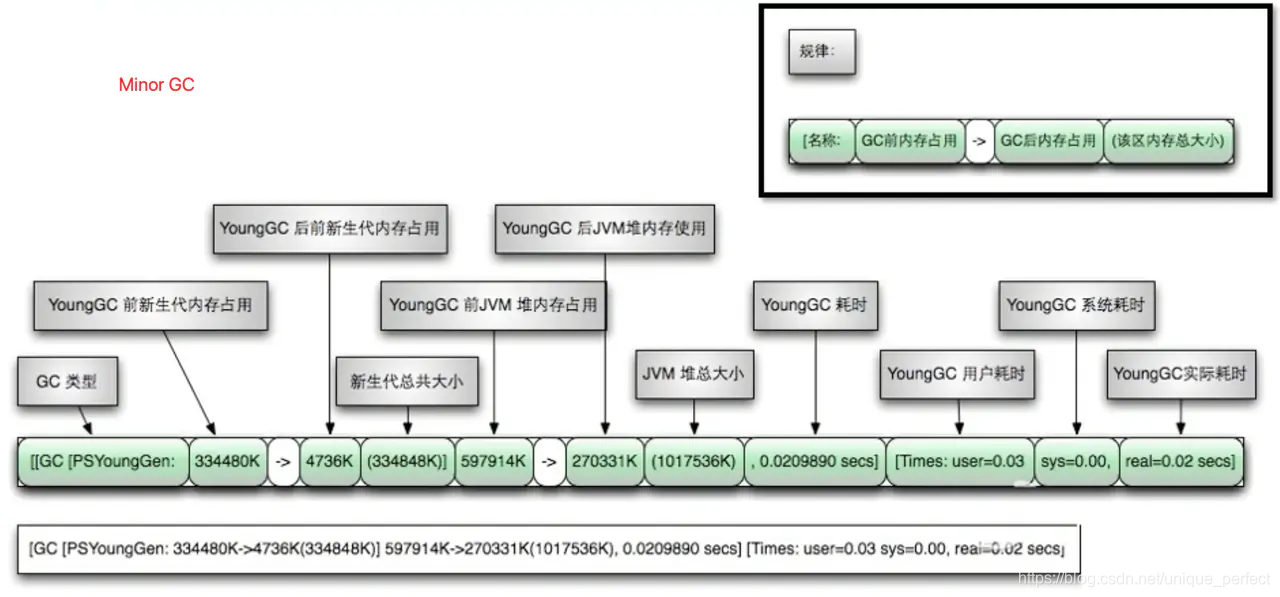-
深入理解JVM(十八)GC日志分析
通过阅读GC日志,我们可以了解Java虛拟机内存分配与回收策略。
内存分配与垃圾回收的参数列表
- -XX: +PrintGC 输出GC日志。类似: -verbose:gc
- -XX: +PrintGCDetails 输出GC的详细日志
- -XX: +PrintGCTimeStamps 输出GC的时间戳(以基准时间的形式)
- -XX: +PrintGCDateStamps输出GC的时间戳(以日期的形式,如2013一05一04T21 : 53:59.234+0800 )
- -XX: +PrintHeapAtGC 在进行GC的前后打印出堆的信息
- -Xloggc: . . /logs/gc. log日志文件的输出路径
- /*
- * JVM参数:-Xms60m -Xmx60m
- */
- public class GCLogTest {
- public static void main(String[] args) {
- ArrayList<byte[]> list = new ArrayList<>();
- for (int i = 0; i < 500; i++){
- byte[] arr = new byte[1024 * 100];
- list.add(arr);
- }
- }
- }
打开GC日志:
-verbose:gc这个只会显示总的GC堆的变化, 如下:
- [GC (Allocation Failure) 15267K->13850K(58880K), 0.0030993 secs]
- [GC (Allocation Failure) 29150K->29068K(58880K), 0.0042701 secs]
- [Full GC (Ergonomics) 29068K->28870K(58880K), 0.0072675 secs]
- [Full GC (Ergonomics) 44230K->44173K(58880K), 0.0083393 secs]
参数解析:
GC、Full GC: GC的类型,GC只在新生代上进行,Full GC包括永久代,新生代, 老年代。
Allocation Failure: GC发生的原因。
15267K->13850K:堆在GC前的大小和GC后的大小。
58880K:现在的堆大小。
0.0030993 secs: GC持续的时间。但是如果想查看更详细的信息, 比如新生代在GC前后的变化或者老年代在GC前后的变化等,
就需要使用这个参数:-XX:+PrintGCDetaiis输出信息如下:
- [GC (Allocation Failure) [PSYoungGen: 15267K->2548K(17920K)] 15267K->13850K(58880K), 0.0028485 secs] [Times: user=0.00 sys=0.00, real=0.00 secs]
- [GC (Allocation Failure) [PSYoungGen: 17848K->2556K(17920K)] 29150K->29068K(58880K), 0.0036911 secs] [Times: user=0.05 sys=0.08, real=0.00 secs]
- [Full GC (Ergonomics) [PSYoungGen: 2556K->0K(17920K)] [ParOldGen: 26512K->28870K(40960K)] 29068K->28870K(58880K), [Metaspace: 3491K->3491K(1056768K)], 0.0066634 secs] [Times: user=0.00 sys=0.00, real=0.01 secs]
- [Full GC (Ergonomics) [PSYoungGen: 15360K->3000K(17920K)] [ParOldGen: 28870K->40872K(40960K)] 44230K->43872K(58880K), [Metaspace: 3491K->3491K(1056768K)], 0.0056879 secs] [Times: user=0.00 sys=0.00, real=0.00 secs]
- Heap
- PSYoungGen total 17920K, used 10054K [0x00000000fec00000, 0x0000000100000000, 0x0000000100000000)
- eden space 15360K, 65% used [0x00000000fec00000,0x00000000ff5d1938,0x00000000ffb00000)
- from space 2560K, 0% used [0x00000000ffd80000,0x00000000ffd80000,0x0000000100000000)
- to space 2560K, 0% used [0x00000000ffb00000,0x00000000ffb00000,0x00000000ffd80000)
- ParOldGen total 40960K, used 40872K [0x00000000fc400000, 0x00000000fec00000, 0x00000000fec00000)
- object space 40960K, 99% used [0x00000000fc400000,0x00000000febea1a0,0x00000000fec00000)
- Metaspace used 3498K, capacity 4498K, committed 4864K, reserved 1056768K
- class space used 387K, capacity 390K, committed 512K, reserved 1048576K
参数解析:
GC,Full FC:同样是GC的类型
Allocation Failure: GC原因
PSYoungGen:使用了Parallel Scavenge并行垃圾收集器的新生代GC前后大小的变化
ParOldGen:使用了Parallel Old并行垃圾收集器的老年代Gc前后大小的变化
Metaspace: 元数据区GC前后大小的变化,JDK1.8中引入了元数据区以替代永久代
xxx secs : 指Gc花费的时间
Times: user: 指的是垃圾收集器花费的所有CPU时间,
sys: 花费在等待系统调用或系统事件的时间,
real :GC从开始到结束的时间,包括其他进程占用时间片的实际时间。加上GC时间:
-XX:+PrintGCTimeStamps- 0.101: [GC (Allocation Failure) [PSYoungGen: 15267K->2552K(17920K)] 15267K->13802K(58880K), 0.0029209 secs] [Times: user=0.00 sys=0.00, real=0.00 secs]
- 0.106: [GC (Allocation Failure) [PSYoungGen: 17852K->2460K(17920K)] 29102K->29012K(58880K), 0.0035817 secs] [Times: user=0.00 sys=0.00, real=0.00 secs]
- 0.109: [Full GC (Ergonomics) [PSYoungGen: 2460K->0K(17920K)] [ParOldGen: 26552K->28870K(40960K)] 29012K->28870K(58880K), [Metaspace: 3491K->3491K(1056768K)], 0.0073870 secs] [Times: user=0.02 sys=0.00, real=0.01 secs]
- 0.118: [Full GC (Ergonomics) [PSYoungGen: 15360K->3000K(17920K)] [ParOldGen: 28870K->40872K(40960K)] 44230K->43872K(58880K), [Metaspace: 3491K->3491K(1056768K)], 0.0042181 secs] [Times: user=0.00 sys=0.00, real=0.00 secs]
-XX:+PrintGCDateStamps- 2022-09-08T11:37:30.424+0800: [GC (Allocation Failure) [PSYoungGen: 15267K->2552K(17920K)] 15267K->13810K(58880K), 0.0027859 secs] [Times: user=0.00 sys=0.00, real=0.00 secs]
- 2022-09-08T11:37:30.428+0800: [GC (Allocation Failure) [PSYoungGen: 17852K->2552K(17920K)] 29110K->29020K(58880K), 0.0034724 secs] [Times: user=0.00 sys=0.00, real=0.00 secs]
- 2022-09-08T11:37:30.431+0800: [Full GC (Ergonomics) [PSYoungGen: 2552K->0K(17920K)] [ParOldGen: 26468K->28870K(40960K)] 29020K->28870K(58880K), [Metaspace: 3491K->3491K(1056768K)], 0.0072200 secs] [Times: user=0.00 sys=0.00, real=0.01 secs]
- 2022-09-08T11:37:30.440+0800: [Full GC (Ergonomics) [PSYoungGen: 15360K->3000K(17920K)] [ParOldGen: 28870K->40872K(40960K)] 44230K->43872K(58880K), [Metaspace: 3491K->3491K(1056768K)], 0.0050960 secs] [Times: user=0.00 sys=0.00, real=0.00 secs]
如果想把GC日志存到文件的话, 是下面这个参数:
-Xloggc:gc.log生成的文件在项目路径下



可以用一些工具去分析这些gc日志。
常用的日志分析工具有: GCViewer、GCEasy、GCHisto、GCLogViewer 、Hpjmeter、 garbagecat等。
-
相关阅读:
STM32使用STM32CubeMX生成文件,并实现串口打印功能。
【KMP】KMP算法的一些小理解&总结
flutter开发实战-防抖Debounce与节流Throttler实现
Nuxt - 每个页面单独设置 SEO 相关标签及网页标题、图标等(页面配置 head)
死锁的常见例子及 Python 模拟
guava本地缓存CacheLoader使用
Commander(指挥官)介绍
这 13 个可能是你一直未使用过的超级棒的 Python 用法
本二成为Java 高级开发:回忆大学在南昌实习,那会儿太嫩了~
redis的原理和源码-主从复制的原理介绍
- 原文地址:https://blog.csdn.net/qq_51409098/article/details/126760708